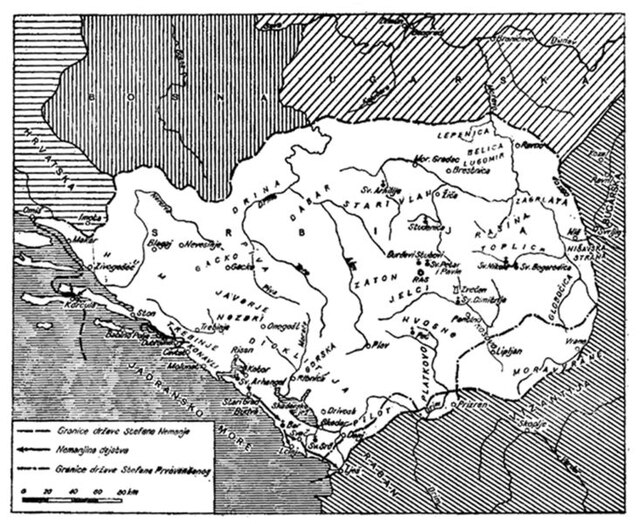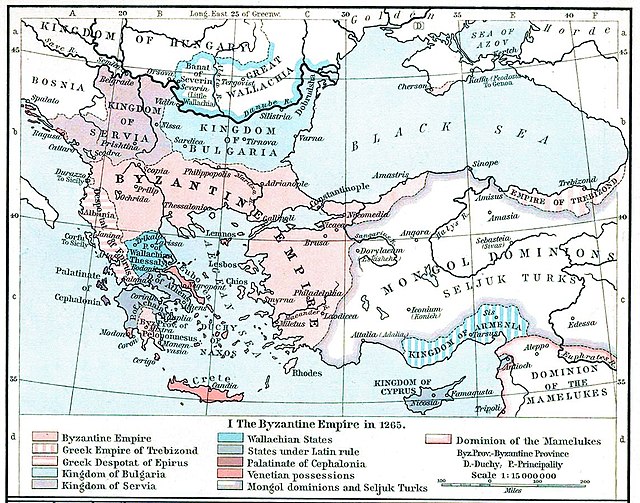Loading AI tools
| This article is rated C-class on Wikipedia's content assessment scale. It is of interest to the following WikiProjects: | ||||||||||||||||||||||||
| ||||||||||||||||||||||||
I presume that the short nope in the summary means denial of the info correctness.
Cetina was the border from the 9th century (at which Serbia was unified, see ). For the border of the Nemanjic territories, see 
In 1322, the region was conquered by the Bosnians, but returned in the middle of the 14th century by Emperor Stephen Dushan. It would then finally be indorporated into the Bosnian state. Isn't that the main part of the Medieval Ages? --HolyRomanEmperor 22:55, 12 February 2006 (UTC)
- As usual, you fail to note that the map is of Serbian origin (University of Belgrade, 1922...), don't mention the sources on which it's based, don't qualify the statement although it's obvious even from this map that it wasn't _Cetina_ that was boundary, but rather its last few miles before emptying out into the sea. Nothing new under the sun, I see. --Elephantus 23:04, 12 February 2006 (UTC)
Let's take it from the top
Ofcourse only the strim of the river that ends near the Adriatic.
Now, take a look at the Pagania article and this image:
The Neretvians re described as a Serbian tribe according to De Administrando Imperio and several other sources. See the border of the map? Arguably, Pagania became a fief of the Grand Principality of Rascia somwhere in early 9th century, accordingly to the fall of the Croatian-in-character Slavic Principality of Dalmatia to the north of the river of Cetina.
Why don't we write then Croat historian claim that the border of Trpimir's/Tomislav's state reached the Drina river. You may also notice that the info on Trpimir is my contribution. I don't question those maps. Those are altogether historical facts (of life).
You might also see that it is a German historical claim... as well, as can be noticed on this map: Serbien, 9 which depicts the middle of the 9th century, the creations of the Grand Principality of Rascia, which engulphed the Principality of Rascia (out of which it was upgraded) and her vassalaged Principalities: Pagania, Zahumlje and the slightly-independent Duklja (Travunia was already a direct part of Rascia since the early ages).
View the article on Prince Časlav Klonimirović. If some sources are need, please see: Neretljani (in the Serbo-Croatian language). If you need to know, most of the info is based again on De Administrando Imperio. However, other sources are several Italian (Venetian mostly) and Byzantine chronicles. Cetina was back then a border between his realm and the Kingdom of Croatia.
I will skip the part of the massive Kingdom of Duklja and Dalmatia (which you can see in the actual article). You may notice that King Stjepan I of Croatia invited the Narentines to join his realm, but the Dukljan conquests smited across the lands, and eventually formalised a firm border on the River of Cetina. Thereby, in the ensuing feudal anarchy that followed (after the fall of this Kingdom), the Grand Principality of Zahumlje "swallows" (sorry for the expression :) Pagania. After the expelling of Desa (see the article on the list of Serbian rulers), the last slightly-independent centralist ruler of the Grand Principality of Rascia and Kingdom of Duklja, the Byzantines have implaced Tihomir, son of the Zahumljan Prince, Zavida as the Grand Prince; the other lands were split among his children: Miroslav got Zahumlje, Stracimir got Duklja and several other fiefdoms, while Nemanja (read the article, if you have time) received a ver small partchment of land in Rascia.
Miroslav's heritage is well-known. You might want to come to the Belgrade Museum yourself and see the famous Miroslav's Gospel. Stefan Nemanja moved quickly, and decisivly defeated Tihomir near Pantino on Kosovo (if you nead more info on this fact, please see History of Kosovo). The actual border of Stephen II Nemanya and his son, Stephen II are not something "resurgent, produced by Vojislav Šešelj" or any other piece of biased historical claims. It is a globally-known historical fact. I will supply you a picture that is not Serbian if you feel that much unnacceptive of anything Serbian, I will display any map of you heart's desire. If you really want to find out on which basis was that map drawn, you just needed to ask: King Stephen II the First-crowned of Nemanya "collected" a biography of hi father, Duke Stefan Nemanja; there it explained the borders of the then-called Serbian Land, including all of Nemanja's conquests, life in Rascia, Zeta (formerly known as Duklja) and Zahumlje including religion and other various age-old information. It was defined in some sort of a Hagyographies delivered to the Monastery of Hilandar in Greece, whose records are still kept.
Now, if you need a map from the... say, 13th century (that is not Serbian, if you are really unnacceptive of "Serbian-"), here:

The map is from The Historical Atlas according to William R. Shepherd, made in 1911. It depicts the year of 1256. The Serbian Kingdom was then ruled by King Uroš I. The border is on the river of Cetina.
Now, the Šubić family have waged a war against Rascia twice attempting to seize Zahumlje, but utterly failing in both times. First in 1303 - 1306, then again by Mladen in 1312 - 1314. Mladen's plights are perfectly described in this book, if you ever want to read it (note: it's in Serbo-Croatian) Kotromanići, undisputably the best book ever written about the same-named Bosnian rulling family. In 1322, the region is finally lost to the arms of of Bosnian Ban Stephen II Kotromanić. Feel free to read his article, as you might see of the resurging counter-offensives of Emperor Stefan Dušan, who again managed to establish a border on the Cetina river, Omiš again becoming the Hungarian-Serbian border Fortress. But in the end, Stephen II of Kotroman had managed to restore the lands, and so do the Medieval Ages soon end.
I have noticed a strange thing: you never reply any post on talk pages as long as the actual article remains of your version. I have no idea why is this, but I have interpreted this as your hope that the other party will forget about the article, or that you can later blame the party for POV-pushing if it edits the article yet again. If you continue at the pace at which you're currently going, 20% of Wikipedia's articles will have POV tags on it (example is our dispute on Lika), so I suggest that you be at least slightly more cooperative in the future. Thank you in advance. --HolyRomanEmperor 14:28, 14 February 2006 (UTC)
- A very instructive post, I must say. However, none of the medieval states you mention actually had "Serbia" or "Serb" in their name. How do you justify the fact that you say in the article it was a border with the "Serbian realm"? It seems we will have to remove that and write "Raška" instead. Or is there something I missed? --Zmaj 17:14, 14 February 2006 (UTC)
- To HRE: You are apparently oblivious of the Greater Serbian agenda you're pushing. I don't mind it really. It's just that you should learn not to be surprised when people recognize it as such and label it accordingly. --Elephantus 21:59, 14 February 2006 (UTC)
- To User:Zmaj: Yes, let's do that. An excellent idea. The problem is - how to name Ceslav's state. We know that he didn't call his realm "Rascia". The Serbian historians simply translated it as "Srpska zemlja" from the hagyographies of the Nemanyid rulers. I think that we'll have to make some sort of a compromise out of this. Tell me please, what's your idea? HolyRomanEmperor 15:31, 15 February 2006 (UTC)
- To User:Elephantus: Basicly, what did your last post say? Other than personal insults, you did nothing. Tell me this: Will it be OK to put Croatian historians claim that Tomislav ruled the territories to the Drina river? --HolyRomanEmperor 15:31, 15 February 2006 (UTC)
- From the above text, I gathered that the various "states" of the region were unstable and shifting entities, probably due to the disordered piratic nature of the Neretvian tribe. Only Stephen II brought some stability, but it's unclear what "Rascia" was in his time, since its border is a conjecture based on older texts. I'll look into other sources and get back to you. --Zmaj 07:50, 16 February 2006 (UTC)
- I've seen Talk:Lastovo. You yourself concluded that the national affiliation of those early medieval states is unclear. I'm removing the "Serbian realm" part. --Zmaj 08:22, 16 February 2006 (UTC)
- to User:Zmaj. Well done! Now, I can't say that I've understood what you meant about the unstability part. It indeed was a terrible time, but it is known exactly when was Zahumlje a vassal of Croatia, or Pagania; or when the four Principalities were subjected to the Grand Princes of Rascia. I know that I am the one main editing those articles; so I'm sorry for the gaps, I promise that they will be filled as soon as possible. --HolyRomanEmperor 20:54, 16 February 2006 (UTC)
"...Cetina Valley and perhaps the river itself became a frontier between Slavic and Late Roman power. ...".
Have the author(s) skipped Avar and Goth invasions, that preceded Slavic invasions? Kubura 11:37, 14 March 2007 (UTC)
Wikiwand in your browser!
Seamless Wikipedia browsing. On steroids.
Every time you click a link to Wikipedia, Wiktionary or Wikiquote in your browser's search results, it will show the modern Wikiwand interface.
Wikiwand extension is a five stars, simple, with minimum permission required to keep your browsing private, safe and transparent.


